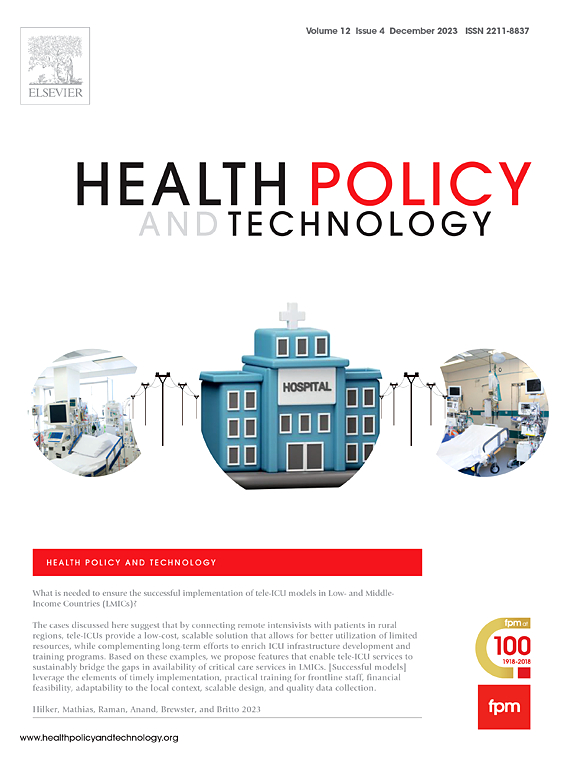Using mental health demand to prioritize areas for improving telehealth capacity
IF 3.7
3区 医学
Q1 HEALTH POLICY & SERVICES
引用次数: 0
Abstract
Objectives
To assess behavioral healthcare demand relative to provider availability and identify public health regions in Nebraska that could benefit from improved broadband access to enhance telehealth services.
Methods
An ecological, cross-sectional design was used. Behavioral Risk Factor Surveillance System, Health Professions Tracking Service, and Federal Communications Commission broadband access data were analyzed. Behavioral health demand was measured through the age-adjusted prevalence of four indicators: binge drinking, marijuana use, diagnosed depression, and poor mental health days.
Results
The percentage of the population lacking broadband coverage ranged from 0.06 % to 66 % across health districts. The ratio of a health indicator (e.g., binge drinking) to the number of providers varied widely. Two health districts with a high ratio of health problems to providers, combined with low broadband coverage, stood out as potential areas that could benefit from broadband expansion.
Conclusion
The findings emphasize the critical need to improve broadband access in rural Nebraska to support telehealth services. Telehealth could be a valuable tool for addressing behavioral healthcare shortages in regions with adequate broadband infrastructure.
利用心理健康需求,优先考虑提高远程保健能力的领域
目的评估行为医疗保健需求与提供者可用性的关系,并确定内布拉斯加州可以从改善宽带接入中受益的公共卫生区域,以加强远程医疗服务。方法采用生态、横断面设计。行为风险因素监测系统、卫生专业跟踪服务和联邦通信委员会宽带接入数据进行了分析。行为健康需求是通过四项指标的年龄调整患病率来衡量的:酗酒、大麻使用、诊断出的抑郁症和精神健康状况不佳的日子。结果各卫生区缺乏宽带覆盖的人口比例从0.06%到66%不等。健康指标(如酗酒)与提供服务的人数之比差别很大。保健问题与提供者之比较高的两个保健区,加上宽带覆盖率较低,是可以从宽带扩展中受益的潜在地区。结论研究结果强调了改善内布拉斯加州农村宽带接入以支持远程医疗服务的迫切需要。在宽带基础设施充足的地区,远程保健可成为解决行为保健短缺问题的宝贵工具。
本文章由计算机程序翻译,如有差异,请以英文原文为准。
求助全文
约1分钟内获得全文
求助全文
来源期刊

Health Policy and Technology
Medicine-Health Policy
CiteScore
9.20
自引率
3.30%
发文量
78
审稿时长
88 days
期刊介绍:
Health Policy and Technology (HPT), is the official journal of the Fellowship of Postgraduate Medicine (FPM), a cross-disciplinary journal, which focuses on past, present and future health policy and the role of technology in clinical and non-clinical national and international health environments.
HPT provides a further excellent way for the FPM to continue to make important national and international contributions to development of policy and practice within medicine and related disciplines. The aim of HPT is to publish relevant, timely and accessible articles and commentaries to support policy-makers, health professionals, health technology providers, patient groups and academia interested in health policy and technology.
Topics covered by HPT will include:
- Health technology, including drug discovery, diagnostics, medicines, devices, therapeutic delivery and eHealth systems
- Cross-national comparisons on health policy using evidence-based approaches
- National studies on health policy to determine the outcomes of technology-driven initiatives
- Cross-border eHealth including health tourism
- The digital divide in mobility, access and affordability of healthcare
- Health technology assessment (HTA) methods and tools for evaluating the effectiveness of clinical and non-clinical health technologies
- Health and eHealth indicators and benchmarks (measure/metrics) for understanding the adoption and diffusion of health technologies
- Health and eHealth models and frameworks to support policy-makers and other stakeholders in decision-making
- Stakeholder engagement with health technologies (clinical and patient/citizen buy-in)
- Regulation and health economics
 求助内容:
求助内容: 应助结果提醒方式:
应助结果提醒方式:


